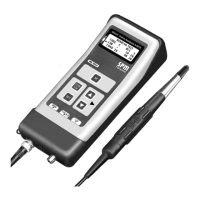11
Technical data are subject to change without notice.
ISO 9001 certified. © Copyright SPM 1996-9. 71411.B
SPM Instrument AB • Box 4 • S-645 21 Strängnäs • Sweden
Tel +46 152 22500 • Fax +46 152 15075 • info@spminstrument.se • www.spminstrument.se
The most important influence on the service life of a
bearing is its lubrication, or, to be precise, the lubri-
cant film between the load carrying rolling elements
and the raceway. By preventing or inhibiting metallic
contact between the loaded bearing parts, the lubri-
cant film reduces the local peak stress in the rolling
interface. The greater the lubricant film thickness, the
more even the load distribution in the contact area,
and the better the fatigue life of the bearing.
Irregularities in the bearing surfaces will always cause
pressure variations in the contact area, and thus shock
pulses, even when metallic contact is prevented by a
separating lubricant film (figure 15A). A thinner film
will result in an increase of the bearing's HR value
(figure 15B).
By measuring the variations in the shock pulse pat-
terns of undamaged bearings, the A2010 can evalua-
te the effect of the lubricant film, and display a LUB
No. which is directly proportional to film thickness.
LUB No. for Ball and Roller Bearings
The LUB No. is displayed together with CODE A and
B. LUB No. 0 means dry running condition. The inter-
pretation of LUB Nos. between 1 and 4 depends on
the bearing type. For ball bearings, LUB Nos. greater
than 2 mean full lubrication (a load carrying oil film).
For roller bearings, a LUB No. greater than 4 indicates
full lubrication.
The term boundary lubrication implies that part of the
load is carried by metal to metal contact.
Factors Influencing Lubrication
The amount of lubricant in or supplied to the bearing
is only one of the many factors that determine lubri-
cant film thickness. Lubricant type and the bearing's
rpm are of great importance, but also the geometry
of bearing parts and housing, as well as the load put
on the bearing by alignment and fitting.
Lubrication Condition
Rolling
interface
A
B
Fig. 15
LUB No. Ball bearings Roller bearings
0 Dry running Dry running
1 to 2 Boundary Boundary
lubrication lubrication
3 to 4 Full lubrication
> 4 Full lubrication
Fig. 16 LUB No. for ball and roller bearings

